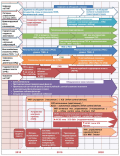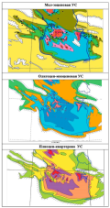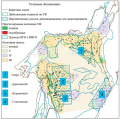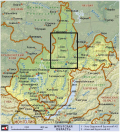GEOLOGICAL EXPLORATION TECHNIQUE
Background. Innovative robotic systems for mineral extraction and processing are increasingly changing the core operational principles of mining enterprises, thus making the creation of an intelligent mining enterprise a reality.
Aim. To develop a set of proposals for promoting the digitalization of the coal industry in Russia by carrying out an analysis of the current state of implementation of innovative equipment and digital technologies within the Industry 4.0 state initiative in Russian coal companies.
Materials and methods. The research was conducted using the methods of systems approach, value chain theory, expert evaluation, technological foresight, logical and comparative analysis, economic and statistical processing of information, including its tabular interpretation. The research materials included the data of coal companies, JSC “Rosinformugol”, Internet sources, and open publications.
Results. The proposal is made to develop five groups of key technological digital industry platforms
(TP), as follows: 1) TP “Prospecting and exploration works”; 2) TP “Underground mining technologies”; 3) TP “Open-pit mining technologies”; 4) TP “Technologies for processing coal and industrial waste”; 5) TP “Technologies for transporting rock mass”. It is proposed to implement the innovative digital potential of the coal industry in two stages, thereby completing the structural and digital transformation of the coal industry.
Conclusion. The proposed TPs of the Russian coal industry should solve the following tasks:
- determination of the basic requirements and functional properties of the Russian coal industry based on the Industry 4.0 state initiative, along with the principles of their implementation;
- determination of the main technological directions for the main sectors (processes) of technological development of the coal industry, including prospecting and exploration; underground and open-pit coal mining; upgrading and processing of coal and industrial waste; transportation of coal;
- identification of the main components, technologies, information and management solutions in all the above processes;
- diversification of the activities of coal mining companies in the creation of products with high added value;
- overcoming the technological gap and import dependence by implementing phased import substitution and innovative development of the Russian coal industry and mining engineering with the achievement of technological sovereignty.
The research results can be used when creating a unified network of scientific and educational centers on the principles of public-private partnership for the development and industrial implementation of innovative technologies in the coal, mining, and exploration industries, as well as in the training of highly-qualified personnel on the basis of Sergo Ordzhonikidze Russian State University for Geological Prospecting.
Background. The task of increasing the efficiency of well construction, reducing the labor- and financial costs involved, and achieving the maximum operational characteristics of oil and gas wells requires the application of the most recent technologies and technological solutions for well drilling and well completion.
Aim. Review and analysis of the implementation and development of promising technologies for well drilling and well completion in the Russian Federation to identify those capable of optimizing well designs, improving the efficiency of technological processes for drilling and completion of exploration and production wells.
Materials and methods. An analysis of accumulated experience, generalization of the results of implementation of modern solutions and technologies for drilling and completion of wells by oil- and gas-producing enterprises of the Russian Federation.
Results. The relevant tasks and directions for improving drilling and well completion technologies and using state-of-the-art equipment are outlined. These solutions can contribute to increasing the efficiency of well construction, reducing the drilling duration of oil and gas wells, and ensuring technological sovereignty.
Conclusion. The considered directions and technologies, as well as their composite tasks and methodological, engineering, and software implementation aspects, can become a subject for research, project, and engineering works, as well as for final qualifying works of students and dissertations.
GEOLOGY AND PROSPECTING FOR HYDROCARBON RESERVES
Background. The formation and placement conditions of hydrocarbon systems and their accumulation in the Turkmen sector of the South Caspian basin are considered.
Aim. To model the existing hydrocarbon systems in the Turkmen sector of the Caspian Sea based on available data.
Materials and methods. Statistical generalization and systematization of available data was carried out. Research materials included fund and reference sources, fieldwork data, and publications by Sh.F. Mehdiyev, I.S. Guliyev, M.Z. Rachinsky, S.S. Djibouti, S.A. Aliyev, V.Y. Kerimov, V.V. Kolodiya, etc.
Data modeling was performed in the PetroMod software.
Results. The conducted numerical modeling established the formation conditions of the key elements of hydrocarbon systems, including oil and gas mother strata, reservoirs, and seals. Hydrocarbon prospects were identified. The main spatial and temporal patterns in the development of generation, migration, and accumulation processes of hydrocarbon fluids were determined, along with the formation conditions of traps. A map depicting potentially promising areas, objects, and plays was drawn. Hydrocarbon prospects were identified. Directions for oil and gas prospecting and exploration in the Turkmen sector of the Caspian Sea were substantiated.
Background. The optimal complex and directions of further geological exploration in the waters of the Sea of Okhotsk are considered. All the promising areas recommended for licensing occupy significant territories and require a step-by-step study, including at the regional and zonal levels.
Aim. Obtaining new full-fledged information through regional geophysical surveys in order to assess new promising areas of the Sea of Okhotsk.
Materials and methods. Systematization of data and statistical generalization, partial borrowing of materials from field data, reference literature and published materials.
Results. As a result of the research, recommendations are given to reduce geological risks, assessment of promising sites, comparative characteristics of resource assessments of the research area. The significant potential of the Okhotsk Sea area may be associated with the lower (Eocene) structural floor. However, these estimates are based on encouraging, but far from complete geochemical information about the potential of the oil and gas mother strata.
Conclusion. It is necessary to carry out an audit of the existing seismic data from the point of view of vertical resolution and establish the current seismic study. Taking into account this information, design and perform additional volumes of 2D seismic exploration sufficient to solve the set geological tasks, the main of which is the construction of a detailed structural framework of the sedimentary cover. The second most important geological task is a large-scale study of the geochemical properties of the organic matter of the rocks of the Eocene part of the section (in outcrops, wells), establishing changes in these properties depending on the paleogeographic situation for their more correct extrapolation to the water area.
MINERALOGY, PETROGRAPHY, LITHOLOGY
Background. Along with ammonites and septaries, concretions with fossils are increasingly being used as jewelry and ornamental materials in Russia. Such concretions are characterized by a wide range of sizes, as well as high decorative and technological properties, making them attractive materials for manufacturing diverse interior and jewelry products. The collection and processing of concretions with fossils was previously carried out in the Ulyanovsk region. In this paper, similar concretions found in the Republic of Kabardino-Balkaria are studied for the first time.
Aim. Tо establish the stratigraphic position, mineral composition, and decorative and technological characteristics of concretions with fossils of jewelry and ornamental quality found in the Republic of Kabardino-Balkaria.
Materials and methods. The collection sites of concretions with fossils and their stratigraphic position were studied. In total, 15 samples characterizing the main decorative and technological types were selected. Interior and jewelry items were manufactured from the concretions; typical samples were studied. A set of studies included the determination of luminescence (8 samples), microhardness (8 cycles), density (6 cycles), optical-petrographic analysis (3 sections), quantitative determination of mineral and chemical composition (2 samples), electron probe studies (2 samples).
Results. Concretions with fossils of commercial quality are associated with lower Aptian deposits, representing marlstone with a large number of shells, mainly ammonites, and, to a lesser extent, bivalves. These comprise (wt %): calcite — 64.0, quartz — 18.7, microcline — 7.4, illite — 5.6, smectite — 2.7, kaolinite — 1.0, strontianite — 0.5, as well as traces of pyrite, apatite, albite, ilmenite, and goethite. Among the impurity elements, Sr in the amount of 0.0402 wt % is recorded.
Conclusions. For the first time, the mineral and chemical (including micro-inclusions and impurity elements) composition of concretions with fossils of jewelry and ornamental quality are established. Factors determining their decorative and technological characteristics are identified. The possibility of using concretions with fossils for manufacturing a wide range of products, including jewelry, is shown. Concretions can be collected simultaneously with ammonites and septaries in river valleys without mining, thereby involving minimal costs and having no negative effect on the environment.
MINERAL AND GEOLOGICAL EXPLORATION ECONOMICS
Background. The mineral resource base is a strategic component of Russia’s economic security, being a critically important tool for strengthening the country’s position in the international arena. At the same time, economic shocks and geopolitical tensions negatively affect the investment attractiveness of geological exploration projects, which are highly important for the continuous reproduction of the country’s mineral resource base.
Aim. Consideration of funding possibilities for geological exploration activities in Russia.
Objectives. 1) To analyze the structure and state of geological exploration funding in Russia over the past five years; 2) to study the prospects and possibilities of attracting investments for different geological exploration stages in Russia; 3) to offer new methods and tools for optimizing the funding of geological exploration activities under the conditions of transformation of the Russian economic system.
Materials and methods. The research materials included domestic and foreign scientific publications; reports and publications of the Federation Council Committee on Agriculture and Food Policy and Environmental Management of the Russian Federation, the Ministry of Natural Resources and Environment of the Russian Federation, the Federal Subsoil Resources Management Agency; the results of the “Geology, Revival of a Legend” initiative; McKinsey and OECD Global Forum on International Investment analytical materials. The materials were analyzed using a set of general and specialized scientific methods. Among them are statistical modeling and forecasting to assess the state and prospects of geological exploration funding in Russia; comparative analysis and synthesis, induction and deduction to study international experience in attracting alternative investments for geological research.
Results. Proposals concerning the possibility of attracting additional funding at various stages of geological exploration through the creation of direct investment trust funds are formulated. Attention is also paid to such methods as streaming and acquisition of a fixed interest rate from production in exchange for an advance payment, which can be applied at later stages of exploration.
Conclusion. New approaches and best international practices should be used to attract funding for various stages of geological exploration activities in Russia. This will make it possible to attract non-governmental resources, diversify methods of financial support, as well as to increase the investment attractiveness of geological exploration projects.
HYDROGEOLOGY AND ENGINEERING GEOLOGY
Background. Changes in the composition of clastic material reflect changes in both the paleogeographic environment and clast transport paths. In turn, this indicates changes in the conditions of regional development. The research relevance is determined by multidirectionality of Earth sciences, such as paleogeography, neotectonics, stratigraphy, hydrology, relief formation, etc.
Aim. To establish the genesis of river valleys and bench complexes in the northern areas of the Irkutsk Oblast.
Materials and methods. The clastic material of the Upper Paleozoic-Mesozoic sedimentary deposits in the northern areas of the Irkutsk Oblast was studied. The work is aimed at reconstructing the contours of sedimentary paleobasins of the Carboniferous, Permian, and Jurassic ages and the conditions of sedimentary strata formation. The results of site investigation and drilling works carried out in the 1960s and 1970s were interpreted from the standpoint of modern information.
Results. The nature of river network formation and clast transport processes was determined. The direction and sources of clast transport were identified, along with the conditions of re-deposition of clastic material at different stages of the geological development of the area under study.
Conclusions. The modern river network in the northern areas of the Irkutsk Oblast is based on the valleys formed under the action of catastrophic glacial water discharge flows.
GEOLOGIC AND PROSPECTING EDUCATION ISSUES
Digitalization concerns all areas of activity of the Southern Federal University, including the educational course “Geological surveying, prospecting, and exploration of solid mineral deposits” taught to students in the Applied Geology program. The competencies of future mining engineers– geologists are designed in close connection with the demands of employers. Computer programs are widely used in the educational process, including Microsoft Word, Microsoft Excel, Microsoft Access, Microsoft Power Point, CorelDraw, Sherpa, ArcGIS, Erdas Imagine, Surfer, Statistica, AutoCAD, Micromine, Surpac, QGIS, and Snap.
CRITICS AND BIBLIOGRAPHY
Carbonate rocks cover one fifth of the Earth’s sedimentary cover, having great economic significance and bearing important information about the mechanisms and settings of their formation. Research into carbonate rocks allows not only the settings of ancient epochs to be reconstructed, but also to the evolution of those settings to be established. Peer-reviewed textbooks are a good source of learning materials for university students investigating the origin and specifics of these rocks.
MEMORIAL
ISSN 2618-8708 (Online)
















































